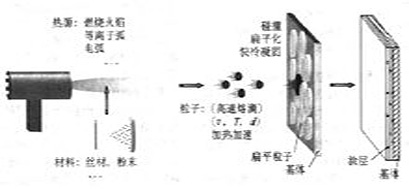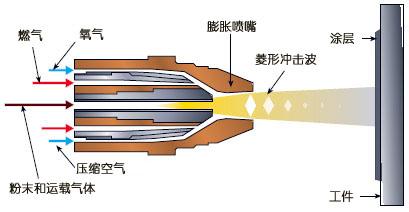Thermal Spray Technology
Thermal Spray Overview
thermal spray technology starting in the early last century, in 1913, Swiss MU schoop invention. Initially, only the flow of molten metal formed by compressed air, sprayed onto the coated surface of the substrate , the formation of a film layer of tissue. sprayed temperature performance of the droplet on the substrate surface and the impact velocity of the material forming the coating layer constituting the core spray technology entire thermal spray technology development substantially along three leading branch line to move forward. temperature and speed depending on the heat source and the device structure. sense, the higher the temperature, the faster, the better formed excellent coating, which led to the temperature and Two elements of the speed of technological development in the whole process of competition and coordination of the situation. variety of coating materials selectively, is another advantage of thermal spray index, which can make the face of different devices to be “ Point iron a gold wearer piercing ”. exactly three elements, the thermal spraying technique to become a truly unique synergistic effect, it is possible to design the desired properties of various surfaces, obtained from the general mechanical maintenance, and bio-tech until the aerospace engineering widely
is a series of thermal spraying process, in these processes, finely dispersed metal or non-metallic coating material to a molten or semi-molten state, After deposition of a surface of a substrate prepared by forming a coating layer is deposited, which is the use of a heat (The arc, plasma spraying or flame combustion) or filamentary powdered metal or non-metallic materials heated to a molten or semi-molten state and then left by the flame itself or to the injection of compressed air at a constant speed of the pretreated substrate surface, having a surface coating formed by deposition of a variety of technical features.
principle of thermal spray


1. Thermal spraying is a surface enhancement technology is an important part of the surface engineering technology, has been focused on the promotion of new technology projects, which is the use of a heat source (such as electric arc, plasma spraying or flame, etc.) will be powdered or wire metal or non-metal-like material is heated to a molten or semi-molten state, and by the flame itself or left at a constant speed jet of compressed air to the pretreated substrate surface, having a surface coating formed by deposition of a variety of technical features
2. Thermal spraying works: is a series of thermal spraying process, in these processes, finely dispersed metal or non-metallic coating material to a molten or semi-molten state is deposited onto a prepared substrate surface via forming a coating deposited layer The coating material may be in powder, strip, filament or rod. thermal spray gun is provided by the fuel gas, electric arc or plasma arc necessary to heat the thermal spray material is heated to a molten or plastic state state, is then subjected to the accelerated air, the particles bound to the beam impact the substrate surface. impinging particle surface, due to stamping and deformation, form a laminate sheet adhered to the substrate surface after the preparation, followed by cooled and build up, eventually forming a laminated coating. coating materials because the coating can be achieved in different temperature corrosion, abrasion, heat, anti-electromagnetic wave functions.
3. Defined: thermal spraying, the spraying material is in a molten state, it is atomized by the high velocity gas stream onto the part surface to form a metal coating layer surface processing method, we called the working surface of the particular “ Tu layer ”, the working methods of manufacture of coatings called “ Thermal Spray ”, which is carried out using a variety of heat and spray painting in general.
4. Use: This allows the high velocity gas stream under the effect of the atomization into fine droplets or particles of a high temperature to a high velocity jet to fly through the surface treatment to form a solid coating layer, thereby to obtain different surface hardness, wear, corrosion, heat, oxidation, heat insulation, insulation, electrical conductivity, sealing, sterilization, anti-microwave radiation as well as other kinds of special physical and chemical properties, which can repair old equipment maintenance, allowing zero scrapped Parts “ revive ”; may also be carried out to strengthen the protection of new products and pre-fabrication to “ longevity ”.
5. Thermal spray materials: spraying powder occupies a very important position in the whole thermal spray materials. Thermal spray powders include nickel-based alloys, iron-and cobalt-based alloy powder, according to different coating hardness, were used in mechanical parts repair and protection.
Technical features
1. The base material is not limited to, metals and non-metals can be deposited on various substrates;
2. Sprayable coating material is extremely broad, thermal spraying techniques may be used to spray virtually all of the solid engineering materials, such as cemented carbide, ceramic, metal, graphite and the like;
3. Spraying too small temperature rise of Matrix material, no stress and deformation;
4. Flexible and convenient operation process, the workpiece shape without limitation, to facilitate construction;
5. Coating thickness from 0.01 to a few millimeters or more than ten millimeters;
6. Coating performance varied form wear and corrosion resistance, heat insulation, anti-oxidation, insulation, electrical conductivity, radiation, etc. with a coating of various special functions;
7. Adaptability and good economic and other advantages.
>> Previous: Coating warranty center
>> Next: Cold Spray Technology







